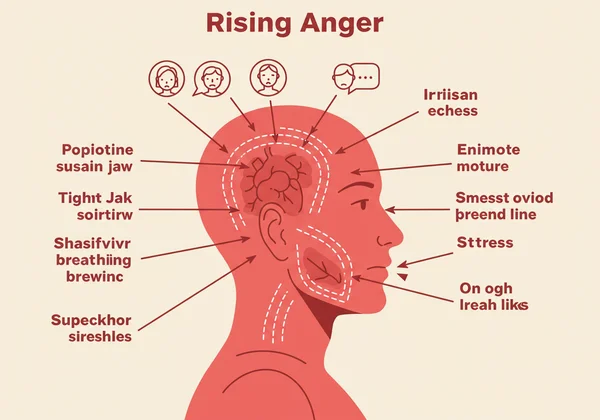Intermittent Explosive Disorder: 10 Anger Management Techniques to Prevent Outbursts
Feeling your anger building, like a storm gathering on the horizon, ready to unleash its force? You are not alone. Many people struggle with intense, sudden bursts of anger that feel overwhelming and uncontrollable, often leaving a wake of regret and confusion. But what if you could learn to read the weather, to intervene before the storm hits? This guide offers ten practical anger management techniques to help you de-escalate rising anger, regain your footing, and prevent those damaging explosive outbursts.
Understanding these intense feelings is a crucial first step. If you've ever asked yourself, What does IED feel like?, it often involves this very sense of losing control. This article provides immediate strategies to help you manage these moments. For a deeper, confidential look into your personal anger patterns, consider starting with a free anger self-assessment to gain valuable insights.

Recognizing the Warning Signs of Rising Anger
Before you can manage an emotional outburst, you must first learn to recognize its approach. Think of it as learning the unique language of your anger. The path to how to control explosive anger begins with self-awareness, listening to the subtle—and not-so-subtle—cues your mind and body send you long before you reach a boiling point. By identifying these early warning signs, you create a critical window of opportunity to apply calming strategies and choose a different response.
What Does "Losing Control" Feel Like?"
For many, the sensation of losing control is a terrifying internal tornado. It often starts as a knot of frustration or irritation that quickly spirals. Your thoughts might start racing, focusing intensely on the source of your anger, replaying the perceived injustice over and over. You may feel a sense of pressure building inside your head or chest, and a desperate urge to "let it out" through shouting, throwing something, or saying things you don't mean. This internal state is a clear signal that your emotional regulation system is becoming overwhelmed.
Your Body's Alerts: Physical & Emotional Cues
Your body sends incredibly honest messages. It reveals the physical signs of rising anger, even when you try to hide them. Learning to spot these physical & emotional cues is like having an early-warning system.
Physical Cues may include:
- A racing heart or pounding in your chest.
- Tightness in your shoulders, neck, or jaw.
- Feeling hot or flushed.
- Shallow, rapid breathing.
- Clenching your fists or grinding your teeth.
Emotional Cues often manifest as:
- Irritability or impatience over small things.
- Feeling defensive or wanting to argue.
- A sense of being trapped or powerless.
- Overwhelming stress or anxiety.
When you notice these signals, acknowledge them without judgment. Simply say to yourself, "I feel my jaw tightening. My anger is rising." This act of recognition is the first, most powerful step in taking back control.

Immediate Calm: Quick De-escalation Techniques
When you feel anger escalating, you need effective calm down methods that work in the heat of the moment. These techniques are designed to interrupt the physiological and psychological stress response, giving you the space to think clearly instead of reacting impulsively. The goal is not to suppress anger but to manage its intensity so it doesn't control you.
Breathe Your Way to Serenity: Deep Breathing Exercises
When you're angry, your breathing becomes fast and shallow, feeding your body's "fight or flight" response. You can reverse this process with intentional deep breathing exercises.
-
Find a comfortable position, sitting or standing.
-
Inhale slowly and deeply through your nose for a count of four, feeling your belly expand.
-
Hold your breath for a count of four.
-
Exhale slowly and completely through your mouth for a count of six, releasing the tension from your body.
-
Repeat this cycle 5-10 times, focusing only on the sensation of your breath.

Grounding Techniques to Reconnect with the Present
Anger can make you feel detached from reality, lost in a storm of emotion. Grounding techniques pull your focus back to the present moment and your physical surroundings.
Try the "5-4-3-2-1" method:
- 5: Name five things you can see around you.
- 4: Identify four things you can physically feel (the chair beneath you, your feet on the floor).
- 3: Listen for three sounds you can hear (a clock ticking, distant traffic).
- 2: Acknowledge two things you can smell.
- 1: Name one thing you can taste.
This simple exercise forces your brain to shift away from emotional intensity and reconnect with the tangible world. If you find these patterns are frequent, an explosive anger test can help you understand your triggers.
Distraction & Time-Out: Shifting Your Focus
Sometimes, the most effective strategy is to create immediate distance from the anger-provoking situation. A strategic distraction & time-out is not about avoidance; it's about giving yourself a necessary pause to cool down.
State clearly and calmly, "I need to take a five-minute break." Step away from the situation. Go for a short walk, listen to a calming song, or do a few stretches. This physical and mental separation can diffuse the immediate intensity and prevent an explosive reaction.
Shifting Your Mindset: Cognitive Strategies for Anger
While in-the-moment techniques are vital, long-term anger management involves changing the way you think. Our thoughts directly influence our emotions. By learning to reframe your perspective and challenge unhelpful thought patterns, you can address anger at its root. These cognitive strategies are powerful tools for building emotional resilience.
Challenging Negative Thoughts: Is It Really That Bad?
Angry thoughts are often characterized by cognitive distortions, like overgeneralizing ("This always happens!") or black-and-white thinking ("It's a complete disaster!"). The key is challenging negative thoughts by questioning their validity.
Ask yourself:
- Is there another way to look at this situation?
- Am I assuming the worst-case scenario?
- What evidence do I have that my thought is 100% true?
- In the grand scheme of things, how much will this matter in a week? A year?
This process, known as cognitive reframing, helps you develop a more balanced and less reactive perspective.
Empathy & Perspective-Taking: Seeing Beyond Your Rage
Anger narrows our focus until we can only see our own pain and perspective. Practicing empathy & perspective-taking can be a powerful antidote. While it doesn't excuse the other person's behavior, it can reduce the personal sting and intensity of your anger.
Try to honestly consider the other person's point of view, even if you disagree with it. What might their motivations be? Are they stressed, scared, or misinformed? Shifting from a mindset of "attack" to one of "curiosity" can dramatically lower the emotional temperature of a conflict.
Empowering Yourself with IED Coping Skills
Integrating these techniques into your daily life transforms them from emergency measures into a robust set of IED coping skills. True empowerment comes from proactively managing your emotional health, not just reacting to crises. It’s about building a foundation of resilience that supports you day in and day out.
Building a Personalized Anger Management Toolkit
There is no one-size-fits-all solution for anger. The most effective approach is building a personalized anger management toolkit. Experiment with the techniques discussed in this article and identify which ones work best for you. Perhaps deep breathing is most effective in the morning, while a brisk walk is better in the afternoon. Keep a journal to track your triggers, your warning signs, and the strategies that successfully de-escalated your anger. This personal data is invaluable for understanding your patterns and refining your approach.
When to Seek Professional Support for Explosive Anger
Self-help techniques are powerful, but they have their limits. If your anger outbursts are frequent, intense, and causing significant problems in your relationships, work, or health, it's a sign that it’s time to seek professional support for explosive anger. This is not a sign of weakness but an act of strength and responsibility.
A mental health professional can provide a formal diagnosis and guide you through evidence-based therapies like Cognitive Behavioral Therapy (CBT). If you're unsure where to begin, a great first step is to explore your anger patterns with a confidential online assessment. The results can provide a helpful starting point for a conversation with a doctor or therapist.

Taking the First Step: Your Path to Managing Anger
Learning to manage explosive anger is a journey, not a destination. It requires patience, practice, and self-compassion. The ten techniques outlined here provide a powerful starting point for regaining control and building a more peaceful life. By recognizing your warning signs, using immediate de-escalation methods, shifting your mindset, and building your personal toolkit, you are taking active steps toward lasting change.
Remember, understanding the problem is the first step toward solving it. If you're ready to gain deeper insights into your emotional responses, take the first step on our homepage. Our free, confidential assessment can help you identify patterns and empower you on your path to emotional well-being.
Frequently Asked Questions About Explosive Anger & IED
How do I know if I have Intermittent Explosive Disorder?
Intermittent Explosive Disorder (IED) is a clinical diagnosis that can only be made by a qualified healthcare professional. Key signs include recurrent behavioral outbursts representing a failure to control aggressive impulses. These outbursts are grossly out of proportion to the provocation and are not premeditated. If you are concerned about your anger patterns, using a preliminary tool like our confidential assessment can offer initial insights, but you must consult a professional for an accurate diagnosis.
Can Intermittent Explosive Disorder be cured?
While there may not be a "cure" in the traditional sense, Intermittent Explosive Disorder is highly treatable. With a combination of therapy (like CBT) and sometimes medication, individuals can learn to recognize their triggers, manage their impulses, and significantly reduce the frequency and intensity of their outbursts. Treatment focuses on developing effective coping skills for a better quality of life.
What causes Intermittent Explosive Disorder?
The exact causes of Intermittent Explosive Disorder are believed to be a complex mix of factors. Research suggests a combination of genetic predispositions, neurobiological differences in brain structure and chemistry (particularly related to serotonin), and environmental influences. Many individuals with IED grew up in families where explosive behavior and verbal or physical abuse were common, suggesting a learned component as well.